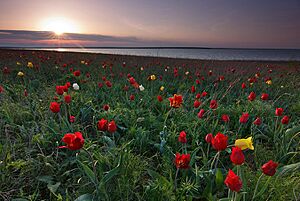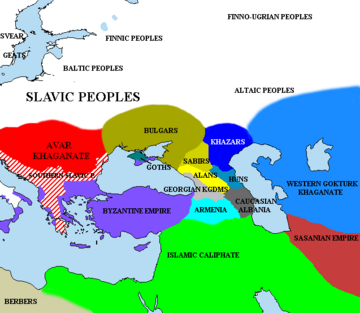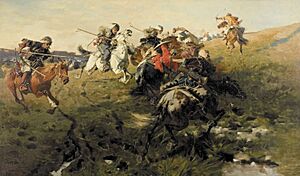Pontic–Caspian steppe facts for kids
Quick facts for kids Pontic–Caspian steppe |
|
|---|---|
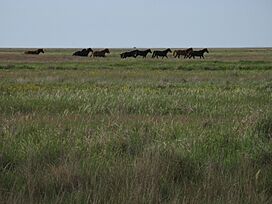
The steppe in Azov-Syvash National Nature Park, Ukraine, with reintroduced horses.
|
|
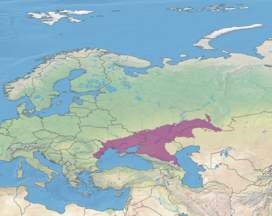
The steppe extends roughly from the Danube to the Ural River. In this map is shown the region known as Pontic Steppe, which is the biggest portion of the whole Pontic-Caspian Steppe.
|
|
| Ecology | |
| Realm | Palearctic |
| Biome | Temperate grasslands, savannas, and shrublands |
| Borders |
List
|
| Geography | |
| Area | 994,000 km2 (384,000 sq mi) |
| Countries | |
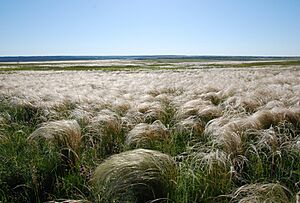
The Pontic–Caspian Steppe is a huge area of flat, grassy land called a steppe. It stretches across Eastern Europe all the way to Central Asia. This vast region gets its name from the Black Sea (also known as Pontus Euxinus in ancient times) and the Caspian Sea.
The steppe starts near the northern shores of the Black Sea and goes north of the Caspian Sea. It connects with the Kazakh Steppe in Central Asia, making it part of the even bigger Eurasian Steppe. Geopolitically, this steppe covers parts of many countries. These include northeastern Bulgaria, southeastern Romania, Moldova, eastern Ukraine, southern Russia (including the North Caucasus and Lower Volga region), and western Kazakhstan.
This area is important in biogeography, which is the study of where plants and animals live. It's part of the Palearctic realm, a major land area for life. It's also known for its temperate grasslands, savannas, and shrublands, which are types of grassy environments.
For thousands of years, many groups of nomadic horsemen lived on this steppe. These groups often traveled far and conquered lands in Central and Eastern Europe, West Asia, and South Asia. Scientists believe that horses were first tamed and used by humans in this very region.
A popular idea in history, called the Kurgan hypothesis, suggests that the Pontic–Caspian steppe was the original home of people who spoke the Proto-Indo-European language. This language is thought to be the ancestor of many languages spoken today, like English, Spanish, and Hindi. Recent scientific discoveries, especially from studying ancient DNA, have largely supported this idea.
Contents
Exploring the Pontic–Caspian Steppe
The Pontic–Caspian steppe covers about 994,000 square kilometers (384,000 square miles). This huge grassland stretches across parts of Central and Eastern Europe. It goes from northeastern Bulgaria and southeastern Romania, through Moldova, and southern and eastern Ukraine. It continues through the North Caucasus region of southern Russia and into western Kazakhstan, east of the Ural Mountains.
To the north, the steppe meets the East European forest steppe. This is a mixed area where grasslands blend with forests. To the south, the steppe reaches the Black Sea. However, the Crimean Mountains and parts of the Caucasus Mountains have different types of forests, like the Crimean Submediterranean forest complex, which mark the southern edge of the steppe.
Near the Caspian Sea, the steppe extends to its western shore in Russia's Dagestan region. But a drier area called the Caspian lowland desert lies between the steppe and the northwestern and northern parts of the Caspian Sea. To the east, the Pontic-Caspian Steppe connects with the Kazakh Steppe.
Ancient Cultures of the Steppe
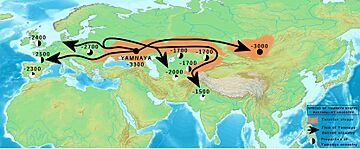
Many different cultures lived in the Pontic-Caspian Steppe long ago. Here are some of the important ones:
- Linear Pottery culture (5500–4500 BC)
- Cucuteni-Trypillian culture (5300–2600 BC)
- Khvalynsk culture (5000–3500 BC)
- Sredny Stog culture (4500–3500 BC)
- Maykop culture (3700–3000 BC)
- Yamnaya/Kurgan cultures (3500–2300 BC)
- Kura-Araxes culture (3000–2000 BC)
- Catacomb culture (3000–2200 BC)
- Srubna culture (1600–1200 BC)
- Koban culture (1100–400 BC)
- Novocherkassk culture (900–650 BC)
Historical Peoples and Nations
Over time, many different groups and nations have lived in or passed through the Pontic-Caspian Steppe. Here's a look at some of them:
- Indo-Europeans (4th millennium BC – today)
- Cimmerians (12th–7th centuries BC)
- Dacians and Thracians (Getae) (11th century BC – 3rd century AD)
- Scythians (8th–4th centuries BC)
- Sarmatians (5th century BC – 5th century AD)
- Ostrogoths (3rd–6th centuries)
- Huns and Avars (4th–8th centuries)
- Bulgars, Onogurs, and Bulgarians (4th–21st centuries), including:
- Great Bulgaria (7th century)
- First Bulgarian Empire (7th–11th centuries)
- Second Bulgarian Empire (12th–15th centuries)
- Principality of Karvuna
- Alans (5th–11th centuries)
- Eurasian Avars (6th–8th centuries)
- Göktürks (6th–8th centuries)
- Sabirs (6th–8th centuries)
- Khazars (6th–11th centuries)
- Magyar tribes (Hungarians) (7th–9th centuries, possibly earlier)
- Rus' people (Kievan Rus') (8th–13th centuries)
- Pechenegs (8th–11th centuries)
- Kipchaks and Cumans (11th–13th centuries)
- Mongol Golden Horde (13th–15th centuries)
- Cossacks, Kalmyks, Crimean Khanate, Volga Tatars, Nogais, and other Turkic states and tribes (15th–18th centuries)
- Russian Empire (16th–20th centuries)
- Mountainous Republic of the Northern Caucasus (19th–20th centuries)
- Soviet Union (20th century)
- Ukraine, Moldova, Southern Russia (21st century)
See also
- Forest steppe
- Indo-European migrations
- Crimean–Nogai raids into East Slavic lands
- Eurasian Steppe
- Haplogroup R1a1 (Y-DNA)
- Haplogroup R1b1 (Y-DNA)
- Kurgan hypothesis
- Late Glacial Maximum
- Steppe Route
- Tarim mummies
- Temperate grasslands, savannas, and shrublands
- Kurgan stelae


